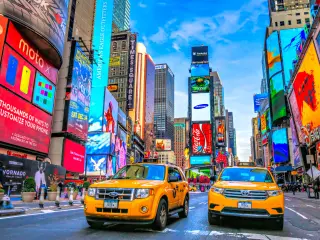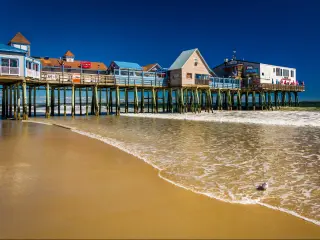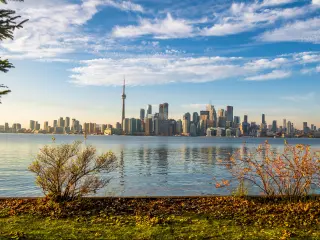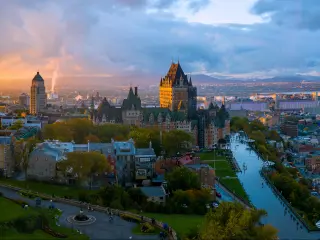Driving in Toronto for the First Time: What to Expect
Head up to the CN Tower's observation decks and you'll be greeted by stunning views across Toronto, the capital of Ontario. Back at ground level, you can admire the impressive skyline of Canada's largest city, stroll along the shores of Lake Ontario, or immerse yourself in the city's thriving arts scene.
Toronto is an easy city to drive in for the first time, with well-kept roads and easy-to-follow signs. However, you might find some of the major streets relatively narrow and as Toronto is a popular and busy city, you'll also have to contend with heavy traffic.
Dozens of different neighborhoods, including Chinatown, Little Italy, and Greektown, create a rich tapestry of cultures across Toronto. making it a fabulous place to visit on a road trip or for a city escape. If you're wondering how driveable Toronto is once you've arrived, we've put together all the information you need to help plan your visit.
Driving in Toronto for the first time
With major roads crossing the city, a block system that's fairly straightforward to navigate, and a downtown that's open to cars, it's possible to drive to most parts of Toronto even if you're not familiar with the city.
Highway 401, one of North America's busiest highways, passes through north Toronto. Reaching up to 18 lanes in some places, it's a memorable stretch of urban driving.
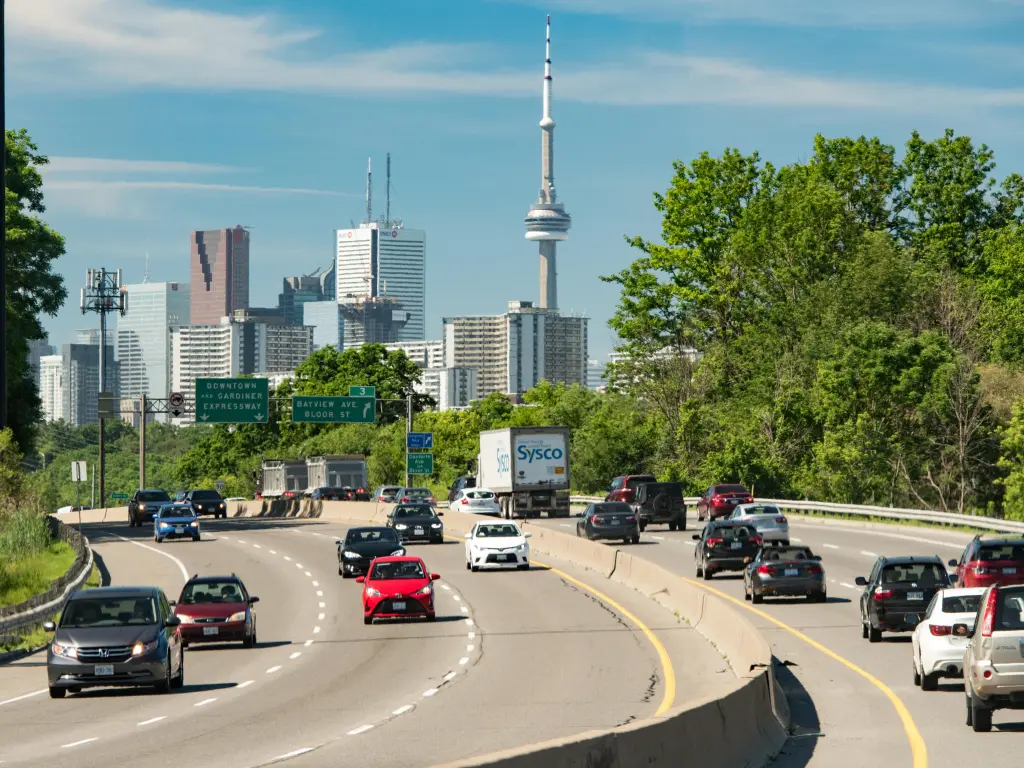
For a more scenic lookout, the Gardiner Expressway runs along the north shore of Lake Ontario and connects different Toronto neighbourhoods. Unsurprisingly, it can get very busy during rush hour.
However, driving in Toronto can present a few challenges even for the most confident urban traveller. Keep on reading to find out some of the key points about driving in the city.
Is Toronto a drivable city?
There's no skirting around the fact that driving in Toronto can be challenging. Heavy traffic can make your visit less enjoyable and one-way streets can make it much harder to reach a destination that feels like it should be just around the next corner.
Keep on reading and you'll find out more about parking, driving rules and travel times to help make your road trip to Toronto as smooth as possible.
However, if you're staying downtown, this is one of those times that we'd actually recommend walking or using public transport. This is often a quicker and cheaper way to get around the city, especially when you've factored in the cost and availability of parking.
You don't really need a car to reach various downtown locations, either.
If you're visiting as part of a longer road trip or you need to drive further out of town, you could also think about staying in a hotel on the outskirts of Toronto. These often have free parking, so you can use public transport to get downtown.
Parking in Toronto
There's no avoiding the fact that parking in Toronto is not only difficult but also expensive. Free parking is rare, if not non-existent, and you can expect to pay around $5 CAD per hour for garages and on-road parking.
It can be hard to find a space in many parts of the city, but you can often book ahead to secure a spot. We'd definitely recommend doing so if you know where you want to park, especially in busy downtown.
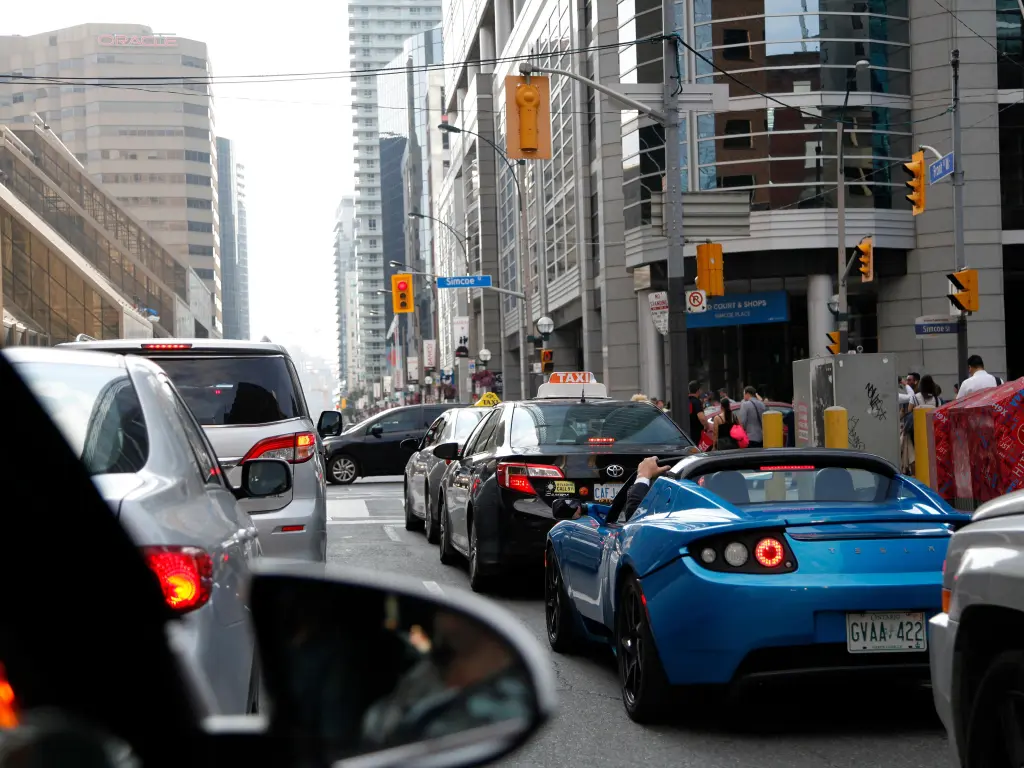
On many streets, parking is limited depending on the time of day. Always check for restrictions if you find an on-street space.
Residents usually need to apply for parking permits for on-street parking on their street. To find out whether a street requires a parking permit, you can check the 'Permit Parking Office'.
If you're visiting friends or family, you can apply for a temporary on-street parking permit for 24 hours, 48 hours or a week. At the time of writing, this will cost around $18 for a 24-hour permit, $26 for 48 hours, or $40 for a week (calculated at the time of writing).
You can sometimes avoid the challenge of searching out a parking space by booking a hotel that offers parking. Even then, there's often a hefty charge for parking.
Driving rules in Toronto
As with any new city, it's important to familiarize yourself with driving rules in Toronto, which might be different to the regulations you're used to.
At pedestrian crosswalks, unmarked or not, always yield and let them pass when turning as they have the right of way.
Keep an eye on the speed limit, which depends on the type of road you're on. Most urban roads are 50 km/h; however, in the city and in residential areas, this drops to 30 km/h or 40 km/h. Expressways such as the Gardiner Expressway range between 80 km/h to 100 km/h.
Drivers who aren't used to a grid system are often confused at being able to turn right on a red light. This is generally allowed as long as you've come to a complete stop first.
However, check to ensure there's no sign stating otherwise, and remember that pedestrians will have priority. Conversely, left turns on a red light aren't allowed. The rare exception is when turning from a one-way street to another.
If you approach a school bus with a flashing red light, you must stop regardless of the direction in which you're heading. U-turns aren't allowed in areas marked as a school zone.
It's also very important to react appropriately to emergency vehicles. Not doing so carries a hefty fine.
If any emergency vehicle approaches with flashing lights, you're required to pull over until it's passed. Slow down, signal, and move to the right side of the road without blocking intersections. Once passed, make sure it's clear and merge back into traffic.
When you see a stopped emergency vehicle, slow down and take caution. If there's more than one lane, leave a lane between you and the vehicle.
Also, remember that if you're involved in an accident causing injury or worse, you must report it to the local police station.
Renting a car in Toronto
If you're travelling to Toronto from further afield, chances are you'll want to rent a car on arrival so that you can explore the city and beyond.
The good news is that hiring a car in Toronto is easy. There are several locations to choose from, whether downtown or at the airport.
The main restriction on renting a car is that you need to be at least 21 years old, and to have more than 12 months of driving experience. Also, 21 to 24-year-olds often have to pay more for the rental.
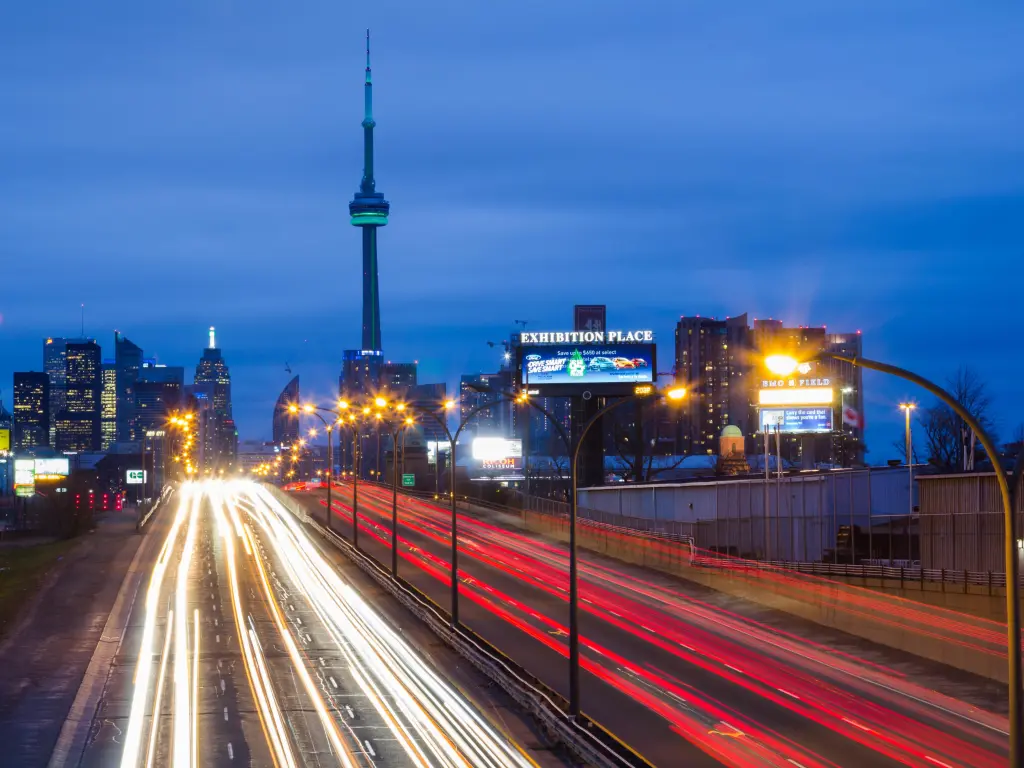
How to reach Toronto
Situated close to the border with the United States and in one of the most densely-populated parts of Canada, Toronto is in easy reach of many other cities.
From Quebec City or Montreal, the highway follows the route of the St Lawrence River and the northern short of Lake Ontario. It's a longer journey if you're coming from the west of Canada, and the quickest route often takes you across the border into the United States then back again at Detroit.
If you're travelling from the US, most journeys will take you via either Niagara Falls or Detroit. It's a relatively short drive on Queen Elizabeth Way from Niagara Falls, or follow ON-401 which runs north of Lake Erie to connect Detroit with Toronto.
| Origin | Distance | Driving Time |
|---|---|---|
| Detroit | 370 km (230 miles) | 4 hours 10 minutes |
| Montreal | 550 km (400 miles) | 6 hours |
| New York | 580 km (360 miles) | 6 hours |
| Quebec City | 810 km (500 miles) | 8 hours |
| Chicago | 820 km (510 miles) | 8 hours 30 minutes |
| Boston | 860 km (550 miles) | 8 hours 40 minutes |
| Atlanta | 1,530 km (950 miles) | 15 hours |
| Winnipeg | 2,030 km (1,260 miles) | 21 hours |
| Vancouver | 4,360 km (2,710 miles) | 40 hours |
Alternatives to driving in Toronto
If you've read this far and decided that you'd prefer not to drive in Toronto, you have some great alternatives.
The core of downtown, including the Entertainment District, is very walkable. The streets are very pedestrian-friendly with sidewalks, and attractions are close together so you can reach major landmarks on foot.
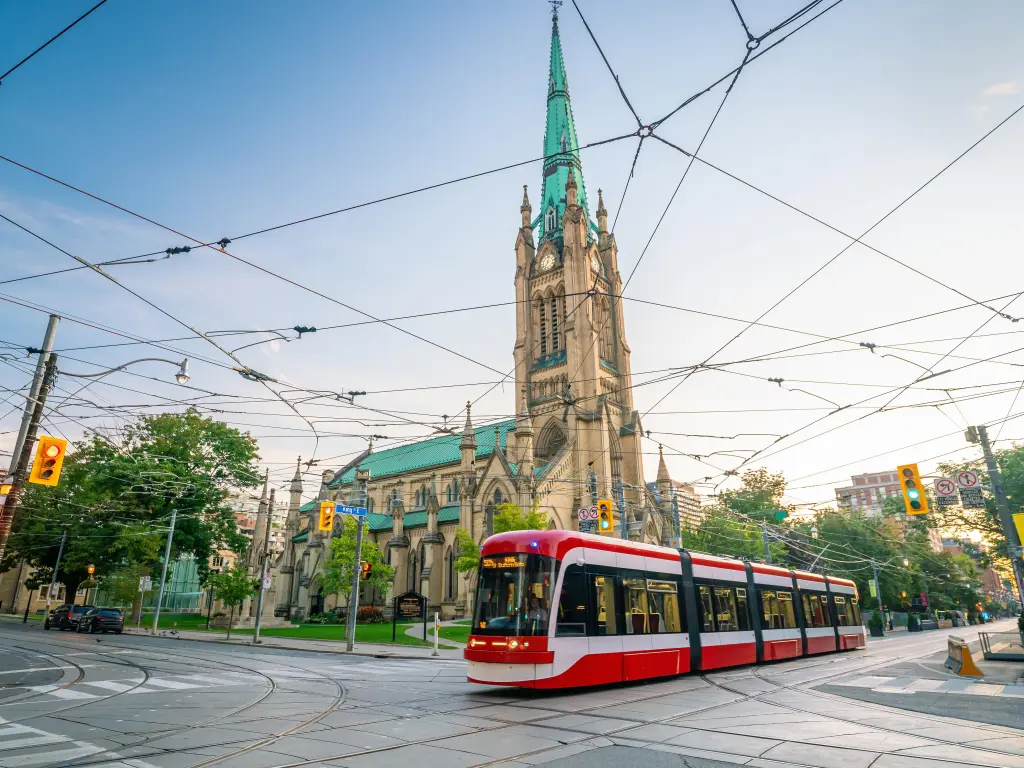
If you'd like to learn more about which neighbourhoods are the most walkable in Toronto, along with a walking itinerary, please check our guide out.
For longer distances between attractions, there's also a good network of subways, streetcars and buses which let you jump between Toronto's many neighbourhoods more easily. However, reaching more suburban neighbourhoods will be easier if you have a car.
Alternatively, if you just need to make a short trip within the city there are car-sharing options which let you hire cars by the hour or day. Popular sites and apps available in the city include Zipcar, Enterprise CarShare and Maven.
Things you need to know about driving in Toronto for the first time
Here's our handy summary of the key things to keep in mind if you're planning on driving through Toronto:
- Traffic congestion is common, so allow extra time for your journey through the city, and try to avoid rush hours.
- There's a wealth of choice and transport such as Streetcars which are an affordable stress-reducing alternative. If you're not confident in navigating unfamiliar city streets, or if you'd prefer to avoid the congestion, you could definitely consider using public transport.
- As you've seen, parking can be expensive and it's often difficult to find a spot. Either use public transport or book ahead.
- Be aware of different driving styles. If you're not used to driving in a metropolis it can be overwhelming.
- Familiarize yourself with road signs. Remember, speed limits will be listed in kilometres per hour not miles per hour.
- Keep up to date with construction zones. Ongoing construction in Toronto can severely increase journey times.
- Always yield to pedestrians at crosswalks. Toronto sees pedestrian safety as a priority.
- Likewise Toronto encourages cyclists and there are cycling lanes in many parts of the city. Stay out of these as they're designated only for cyclists.
- Be cautious in winter. Snow and ice can make driving more challenging. Make sure your vehicle is winter-ready.
- Some highways such as the 407 have tolls. Check for toll requirements and payment methods.
Things to see once you arrive in Toronto
Toronto is packed full of amazing sights, museums and attractions. Looking out over Lake Ontario, and with dozens of different neighbourhoods, there's something for every visitor to enjoy.
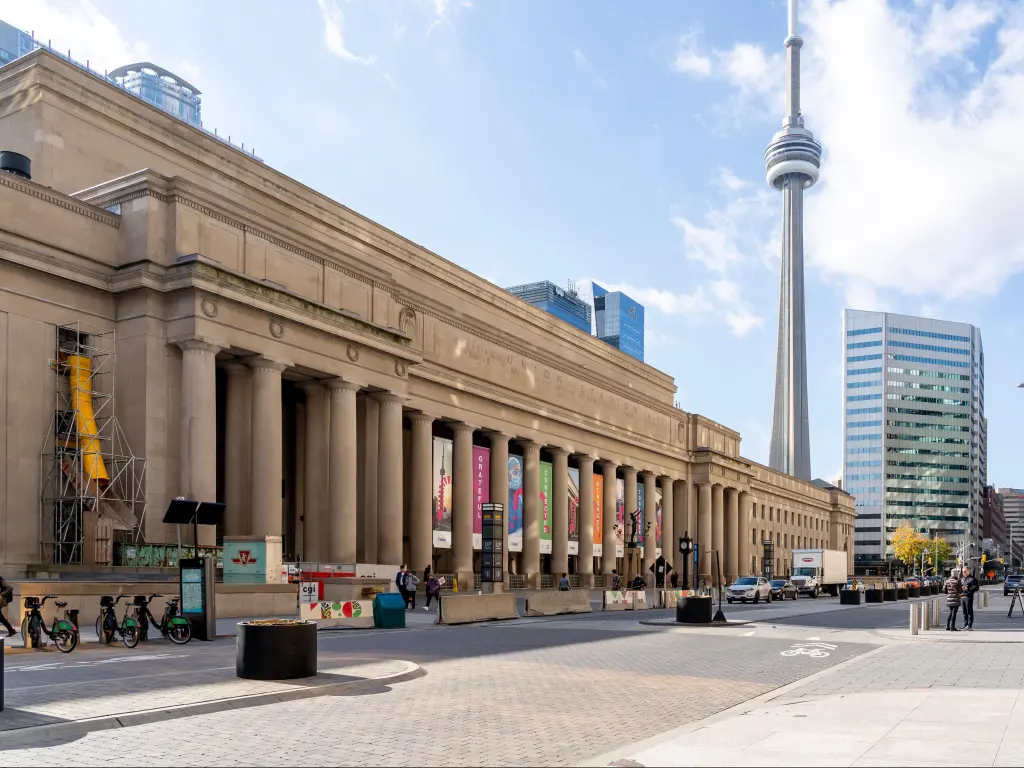
- CN Tower - Dominating the city's skyline, the CN Tower is an iconic symbol of Toronto. It offers breathtaking views from its observation decks and the thrilling EdgeWalk experience, where visitors can walk around the exterior of the tower's main pod.
- Royal Ontario Museum (ROM) - This renowned museum showcases a vast collection of art, world culture, and natural history exhibits. Its striking architecture, a blend of historic and modern design, is a must-see in itself.
- Toronto Islands - A refreshing escape from the city bustle, the Toronto Islands offer beautiful parklands, beaches, and stunning views of the city skyline. Accessible by ferry, they provide a great spot for picnics, biking, and leisurely walks.
- Distillery District - A unique historical and cultural landmark, the Distillery District is known for its well-preserved Victorian-era industrial architecture. Today, it's a vibrant area filled with art galleries, restaurants, and boutiques, hosting various arts and cultural events.
- Ripley's Aquarium of Canada - Located at the base of the CN Tower, this aquarium offers an immersive experience into the underwater world. It features a wide variety of marine life, interactive displays, and a moving walkway through a glass tunnel that provides close encounters with sharks and other sea creatures.
Whether you decide to drive through the city, explore on foot or hop onto public transport, you'll find plenty to keep you busy during your trip to Toronto.

